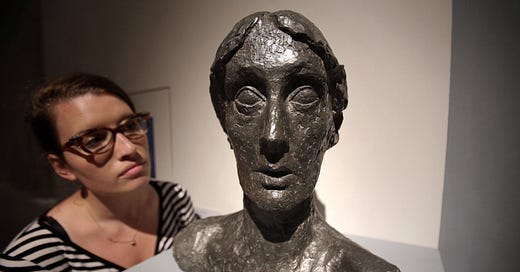Putting the past on trial
A QR code has been added to a statue of Virginia Woolf so that visitors can learn about her “unacceptable” views. But why judge historical figures by the standards of the 21st century?
If you pass through Tavistock Square in Bloomsbury, London, you might happen upon a statue of Virginia Woolf that was erected in 2004. You will already know that Woolf was a leading figure in the Bloomsbury Set, that coterie of artists and intellectuals that included E. M. Forster, John Maynard Keynes and Lytton Strachey. But if you scan the QR code next to this statue you can also learn that Woolf was a vile racist who must be condemned by all right-thinking individuals.
Historical context is all very well. When it comes to Woolf, perhaps a few details about her novels To the Lighthouse or Mrs Dalloway would be appreciated, or some information about her relationship with Vita Sackville-West. But no, instead we are to be hectored about her “challenging, offensive comments and descriptions of race, class and ability which would find unacceptable today.” One wonders what the person responsible for these judgmental remarks has ever accomplished, if anything at all. These petty moralists are like the crabs in the bucket, pulling down the most accomplished out of envy and spite.
The best approach to writers of genius is humility, but this quality seems to be on the decline. We see evidence of this in the self-importance of those who have rewritten books by P. G. Wodehouse, Ian Fleming, Agatha Christie and Roald Dahl. It should go without saying that Wodehouse’s prose cannot be improved, least of all by know-nothing activists who have inveigled their way into the publishing industry.
I recently bought the complete set of Fleming’s James Bond books, but I had to seek out second-hand copies to ensure that they had not been sanitised by talentless “sensitivity readers”. Yes of course, these books include sentiments that are unacceptable by today’s standards. But what’s so wrong with that? “All women love semi-rape” is a shocking sentence – in this case, it’s by the female narrator of The Spy Who Loved Me (1962) – but what purpose does censoring the passage actually serve?
The rewriting of books and the creation of cautionary QR codes are symptoms of our current strain of puritanism. These are the descendants of those religious zealots who shut the theatres in 1642 out of fear that the masses might be corrupted. And while I concede that Ian Fleming’s views on relationships between the sexes may not have been progressive, I don’t feel the need to be berated about it before enjoying the adventures of James Bond.
It’s not as though Bond is even meant to be a likeable character; the man has a licence to kill, for heaven’s sake. This isn’t someone you’d wish to invite to a dinner party. In that regard he’s reminiscent of the hero of George MacDonald Fraser’s Flashman series, a character based on the bully from Tom Brown’s School Days by Thomas Hughes. He’s a violent boorish rapist, but the novels are still entertaining because most of us aren’t reading them for moral instruction.
In exploring the gamut of human experience, writers will often feel compelled to recreate the grotesque, the uncomfortable, the outrageous, even the downright evil. Who ever supposed that works of fiction should restrict themselves to rose-tinted idealisations of human existence? Imagine Macbeth without the regicide, or King Lear without the eye-gouging, or Titus Andronicus without the cannibalism. Would Dante’s Divine Comedy retain its power if some “sensitivity reader” excised the Inferno?
Keep reading with a 7-day free trial
Subscribe to Andrew Doyle to keep reading this post and get 7 days of free access to the full post archives.




